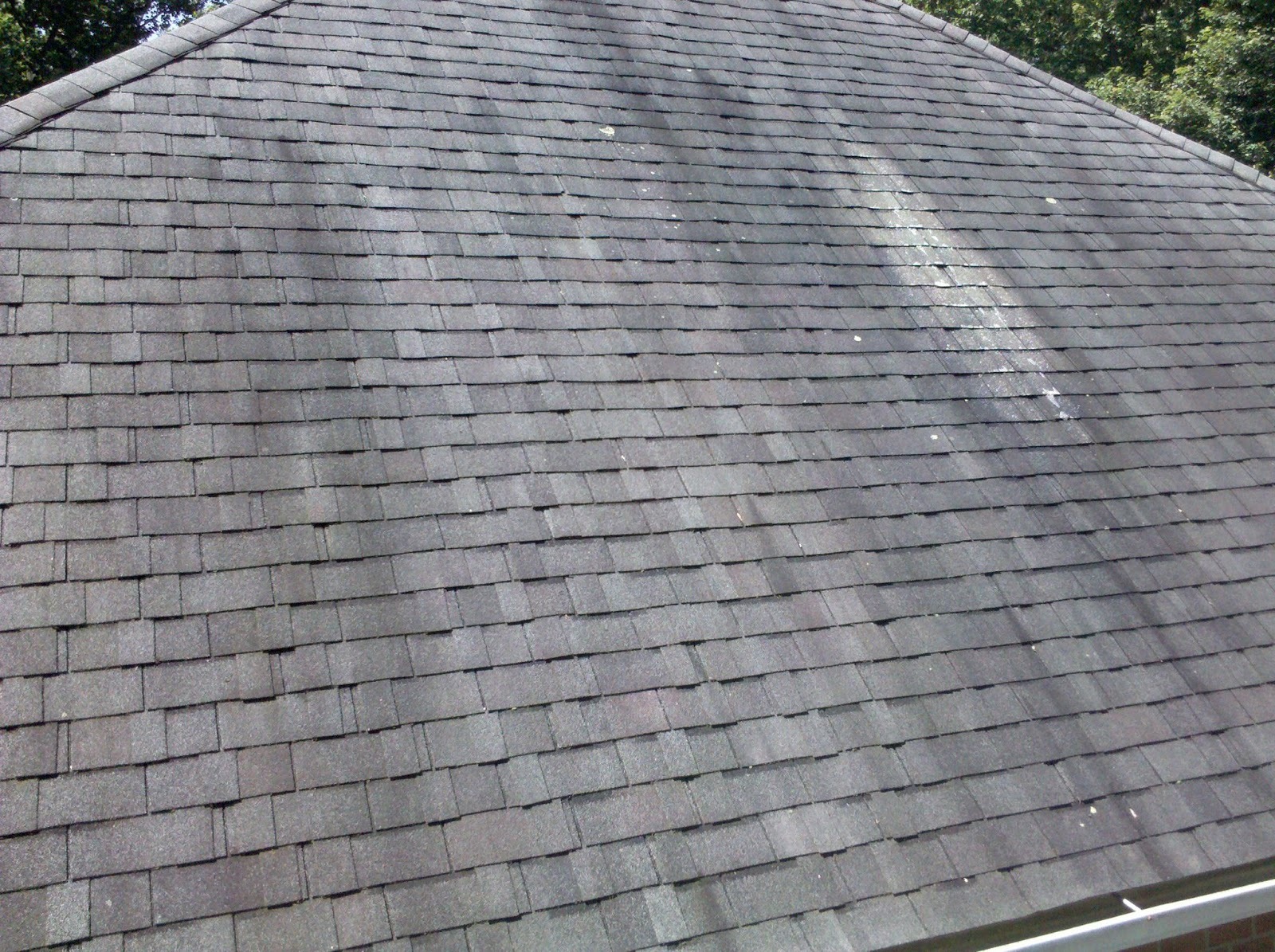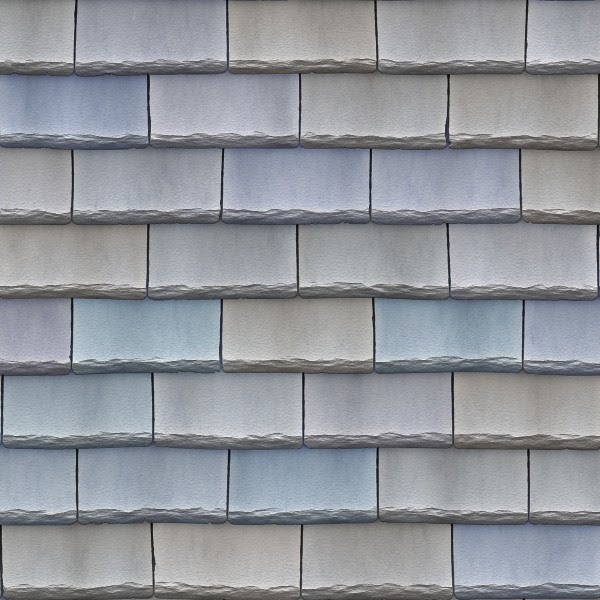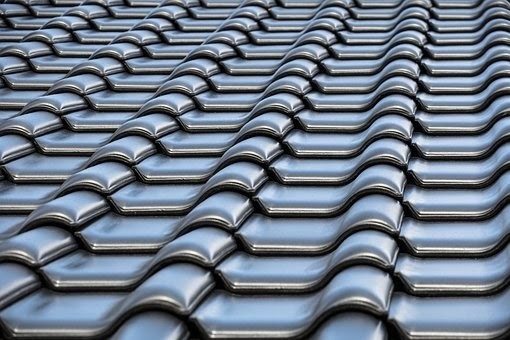Homeowners can now choose between numerous types of slate roofs best suited to their design, budget, and location. Historically, homeowners used natural slate roofing for its elegance and beauty, bringing to mind a magnificent northwest mountain range. It also can add distinction and value to a home. However, the high installation costs of labor-intensive natural slate, along with its susceptibility to cracking and breaking, discourage many homeowners from using natural slate roofing.
6 Unique Types of Slate Roof
Fortunately, manufacturers offer several other unique, aesthetically beautiful types of roof slates as alternatives to natural slates: fiber cement, bituminous, concrete, metal, and synthetic composite slate.
1. Natural Slate

Fine-grained-foliated natural slate contains grains of mica (in small, irregular scales), chlorite (in flakes), and quartz (in lens-shaped grains). It easily splits into a thin slab, creating an attractive roofing product. Homeowners and architects value natural slate because it comes in many textures and beautiful colors: green, grey, red, purple, black, and brown. Natural slate, when properly maintained, provides fire, pest, and moisture resistance. A well-cared-for natural slate roof can last more than 100 years.
Unfortunately, the high cost of materials and installation may deter many homeowners from using natural slate. Installing natural slate (800 to 1,500 pounds per square) requires an experienced contractor that specializes in slate roofing.
A slate roof costs $9 to $16 ft2 to install — the most expensive roofing material on the market:
- Slate shingles cost from $500 to $1700 per square, depending on the color, durability, and thickness you choose. In addition, other materials, like underlayment, drip edging, and special tools needed for the job will add $100 per roofing square.
- Labor costs to install a natural slate roof range from $600 to $1,500 per roofing square, based on the slope, pitch, and size of a home's roof.
- The weight of natural slate makes it challenging to handle. It also often requires extra structural support to the home or building, which both add to the installation costs.
- Fragile natural slate can break during and after installation, mainly if walked on. A broken slate tile needs immediate repair to prevent moisture damage to the home. You may find it challenging to replace a natural-slate-roof tile with an exact match because of the variations between each lot of slate tiles.
2. Fiber Cement Slate

Fiber cement slate roofing costs $3 to $16 ft2 to install.
Manufacturers use sand, cellulose fibers, and cement to produce fiber cement slate roofing, a cheaper alternative to natural slate roofing. Before the 1980s, fiber cement also included asbestos. Fiber cement slates come in a wide variety of factory-applied colors and custom formats such as diamond-shaped slates. Fiber cement slate provides good water, fire, and insect resistance.
Unfortunately, the instability of cement makes fiber cement slate roofing prone to breakage. In addition, long-term exposure to wind can damage the roof, allowing water to penetrate, damaging the roof and structure. Fiber cement slate roofs require regular inspections and maintenance to ensure the expected lifespan of 20 to 25 years. They also need repainting every 10 to 15 years, adding more to maintenance costs.
3. Bituminous Slate

A bituminous slate roof costs $4 to $13 ft.2 to install, depending on the materials and roof’s size and slope.
Manufacturers use bitumen (asphalt) to make both bituminous slate and asphalt shingles, resulting in similarly expected life spans, maintenance requirements, and installation processes. However, asphalt shingles have a rough, sandpaper-like feel, while bituminous slates have a smooth surface like natural slate. Therefore, homeowners looking for an inexpensive way to achieve a slate design pattern should consider bituminous slate roofing. The flexibility of bituminous slates allows installation over eyebrow windows and domed roofs.
There are situations that can damage bituminous slate roofing, over time, diminishing its integrity and lifespan.
- Improper installation significantly lessens an asphalt shingle's wind resistance.
- Evaporation and moisture dissipate the volatiles in the roofing, causing the asphalt to dry, shrink and crack (craze-cracking), permitting water to get beneath the roof system, damaging the roof and building.
- Pulverized stone and polymers (fillers) give the bituminous slate ductility, strength, and impact resistance. Too little filler leads to soft and flexible shingles, lessening their wind resistance, causing them to crease, fracture, tear or pull over the heads of fasteners during and after installation. Too much filler makes shingles brittle, reducing their service life, often becoming damaged during transportation and installation.
- Below a bituminous slate transition temperature, the roof loses its ductile properties and fractures more easily.
- Bituminous slate softens at high temperatures, then hardens as it cools, causing the shingles to become brittle. The brittle shingles burn through in spots or break at the edges, permitting water to get beneath the roof, damaging the building and roof.
- Over time, the UV protective granules on the bituminous slate's upper surface loosen and drop away, permitting the UV rays to break down the asphalt.
- A lack of good ventilation in the roof can lead to heat and moisture buildup. Excessive heat and moisture damage the felt roofing underlayment, reducing the bituminous slate shingles' service life.
4. Concrete Slate

Concrete slate roofing costs between $3 and $5 ft2 to install.
Concrete slate is another cheaper alternative to natural slate. Manufacturers make concrete slate from a natural mixture of cement, sand, water, and oxide. Energy-efficient concrete slate can help lessen energy costs by permitting air to circulate under and through the roof, decreasing the heat transfer into the attic. When properly installed, noncombustible concrete slate roofs can stand up to severe weather, impact, and freeze-thaw cycles, for a lifespan of 50 years.
It is important to know that concrete slate roofs require extensive routine maintenance and repairs to preserve both their appearance and integrity.
- Moss and mildew tend to grow between concrete slate tiles, especially in wet climates, requiring annual professional power cleaning.
- Homeowners must inspect their roofs for damaged tiles, particularly after a severe weather occurrence, immediately repairing or replacing the damaged tiles to avoid harming the house's underlayment and interior.
- A concrete slate’s color fades over time, and the tile's porous nature makes it prone to staining. Therefore, homeowners must repaint a concrete slate roof every couple of years to keep it looking new.
- Concrete roofing tiles can last 50 years; however, you must replace the underlayment after 20 years, a tedious, time-consuming, and costly project. Replacing the underlayment of a 1500 ft.2 concrete tile roof costs about $5,400 to $7,660, including labor.
- The weight of concrete makes installation difficult and often requires added structural reinforcement to the house. In addition, algae can grow on concrete slate, requiring a homeowner to hire a professional to pressure wash the roof periodically.
- Concrete slate tile roofs will absorb water at a rate of 13% if not adequately treated and waterproofed. Water absorption can cause mold, potentially deteriorating the roof. Furthermore, the water's added weight in the concrete slate will put more pressure on the house, leading to significant structural issues.
5. Metal Slate

Metal slate roofing costs between $6 and $12 ft.2 to install depending on the roof’s slope, size, and materials.
Eco-friendly and energy-efficient metal slate roofing provides durability, resists severe winds, moisture, mold, pests, and fire, and has a lifespan lasting 40 to 70 years. Manufacturers produce metal roofing in rigid sheets (typically made from zinc, copper, steel alloys, and expensive copper) with modular press-formed and vertical-seam panels painted or coated or with granules. The granules help protect the roof against scratching and denting from foot traffic, hail, and flying debris.
However, metal slate roofing integrity quickly diminishes if exposed to excessive impact, extreme temperatures, and harsh sun and water exposure.
- Cooling causes the roof to contract. Heat thermally expands a metal roof. The contraction and expansion degrade the stack flashings around pipes, sealants, leading to roof leaks and early roof failure.
- Hail, foot traffic, and flying objects can dent metal. Denting weakens the roofing, causing leaks.
- Metal roof rust may occur due to ponding water or heat from direct sunlight wearing down the roof, causing holes, scaling, and significant building and roof damage.
- To avoid ponding, only install metal slate roofs on roof slopes of 3:12 or greater.
- Improperly installed metal roofs, particularly those with exposed fasteners, can leak.
- The excessive noise on metal roofs during heavy rain and hail storms diminishes the home's or building's indoor environmental quality.
6. Composite Synthetic Slate

Synthetic composite slate roofing tiles cost between $5 and $12 ft2 to install.
Synthetic composite slate, like Brava's Old World Slate, provides many benefits as a type of slate roof. Notably, lightweight composite slate does not require additional structural support, like natural and concrete slate roofing, saving time and money. Synthetic composite slate also provides superior durability against UV rays, moisture, foot traffic, temperature shifts, and impact, than natural, fiber cement, bituminous, and metal slate roofing. Synthetic composite slate limits breaking, cracking, denting, and shrinking, lessening maintenance and repair costs. Furthermore, low-maintenance synthetic slate retains its elegant-beautiful color for its lifetime, unlike concrete slate.

Eco-Friendly Synthetic Composite Slate
Synthetic composite slate has several eco-friendly features. For example, the manufacturing of Brava composite tiles includes entirely recycled plastics and other sustainable products. Brava tiles also reflect solar heat, helping to save energy and lower cooling bills.
Choose Composite Synthetic Slate Roofing From Brava for the Best Results

Eco-friendly Brava Old World Slate is a unique type of slate roof, with exceptional durability and energy-efficiency compared to other types of slate roofing: natural, fiber cement, bituminous, concrete, and metal. In addition, Brava’s composite tiles maintain their beauty and charm for the roof's lifetime with practically zero maintenance. Brava backs all their products with a 50-year-limited warranty.
Get Long-Lasting, Durable and Beautiful Composite Slate with Brava
Long-lasting tiles offer excellent protection against freezing temperatures, fire, wind, and hail:
- Have a Class 4 impact rating with a wind resistance of 188 + mph with ring shank nails
- Have Class A and C fire ratings
- Maintain their integrity through freeze/thaw cycles, as well as extreme heat.
- Do not absorb moisture, and therefore, resist unhealthy and damaging mold.
Lightweight and easy-to-install Brava Old World slate-roofing shingles eliminate costly substructure modifications and reduce shipping costs. We're happy to offer quotes, help you to find a contractor, and will even send a free sample for you to inspect. Order a complimentary lookbook or upload your home's image to our visualizer and see how it would look with our tiles!
Contact us today to see how we can update and upgrade your roof with modern and sustainable roof tiles, carrying the aesthetic of tradition.
For more homeowner information, please visit the links below:



